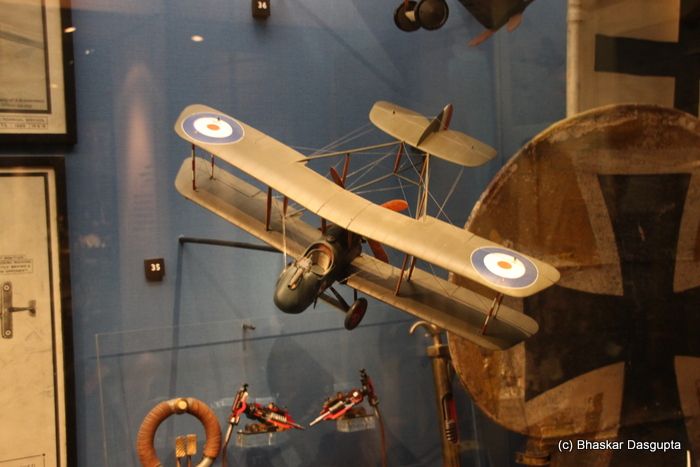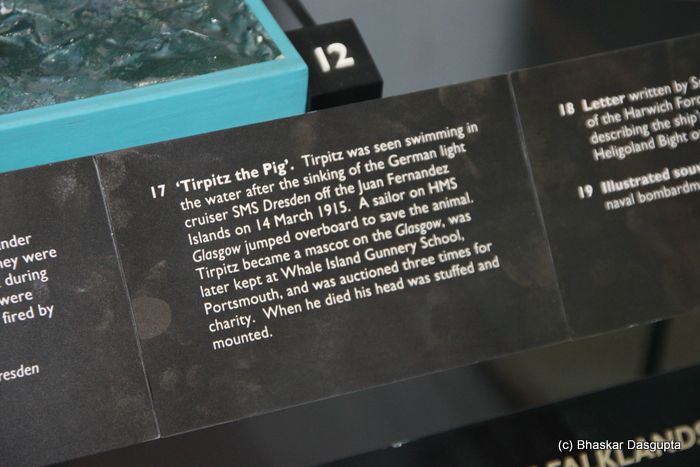This is the eleventh in the series of photo essays of my visit to the London Imperial War Museum.
Inside the basement, there are two giant exhibits, one for WW1 and another for WW2, which traces how the war began, how the war was fought and how it ended, with arms, ammunition, uniforms, scale models, maps, etc. etc. Seriously, each exhibit would take up to 1 day to properly do justice and I was running out of time, it was already late afternoon and I still had to do the top 4 floors.
So I just managed to take some photos of the WW1 gallery and then went through a light and sound show of the Blitz.

As I walked in, I saw this portrait of a Sikh Soldier, Havildar Gurbaksh Singh. Who was massively decorated for bravery. Here are his citations for the IDSM and MM (during WW2) bravery awards:
Havildar Gurbakhsh Singh, then a Naik, was serving with 9/14 Punjab Regiment, Indian Army, when he was awarded the Indian Distinguished Service Medal (IDSM). On 9 February 1945, during the fighting in the Arakan, Burma, at Dathwekark Chaung Road, during the attack on a Japanese position, Gurbakhsh Singh was a Section commander in the leading platoon of one of the two forward companies. In spite of very heavy casualties caused by accurate and heavy enemy fire this NCO led his section with outstanding skill and bravery right on to the top of the enemy's bunkers. On arrival there, when all but two of his sections had become casualties, he closely engaged the enemy and thereby greatly assisted the rest of his company to continue the advance. He remained in this very exposed position until eventually ordered to withdraw some two hours later. He displayed magnificent courage and a complete disregard for his own safety. His personal example proved an inspiration to all ranks who saw him, and his skill and ability had a marked effect in assisting the remainder of the attackers to advance.
Second World War Military Medal awarded to Havildar Gurbakhsh Singh. On 7 June 1945, he was in command of a special patrol sent out to observe a known enemy defended position in the Sauauang area. By dawn his patrol was in position and shortly afterwards he saw a party of some 25 Japanese go past his position towards the British lines. Immediately appreciating the fact that these enemy were certain to bump into British troops a little further back, he decided to let them pass planning to attack them on their way back. The enemy duly made contact and withdrew again past Gurbakhsh Singh's position. He immediately engaged them and inflicted casualties. More enemy appeared and his patrol was cut off from its base. He divided his patrol into two parts one of which was able to return to the British lines while he and the remainder stayed in position to cover them out. It was now impossible for him to return direct to base so, having assured himself that one half of his patrol was safe, he led the remainder through enemy lines. For 24 hours he remained in thick jungle in the middle of a strongly defended enemy area. He was fired at on several occasions and managed to account for two more enemy with a grenade. During the time that he was within the enemy lines he made full and accurate notes of enemy dispositions. The next morning taking advantage of the British artillery shelling on the area in which he was hidden, he led his patrol back by a circuitous route returning to base 36 hours after he had set out. By his bold and determined action this Non-Commissioned Officer undoubtedly saved the whole of his patrol and also obtained most reliable information. Two days previously he had successfully led another patrol close to a strong enemy position and throughout the period when his Company was operating in this area he showed most marked gallantry and leadership and was a fine example to his whole Company. Gurbakhsh Singh had previously, (in February 1945, during the fighting in the Arakan, Burma) won the Indian Distinguished Service Medal.
A soldier who has been gassed…
A trench corpsman trying to save a wounded soldier. 
This is Tirpitz the Pig. He previously belonged to the SMS Dresden cruiser but was found swimming in the sea after it was sunk. A British seaman jumped into the water to save it and then it became a mascot for HMS Glasgow. What an interesting story. 
Uniforms of SMS Dresden which was sunk in the WW1
Then I spent some time with the air display section. 











Fascinating displays of models…
It was difficult to take photographs inside the basement, too little light and too thick glasses. So I stopped taking any more photographs but this one I did want to take. This display showed how close people came to death
A hat with a bullet passing through the front. 
A bullet which shattered the hip flask. 
A bullet which was stopped by a notebook
A heavier calibre bullet which went through another thick bible. Amazing how close people come to death…
Fascinating exhibit, I have to go back there with more time in hand…







No comments:
Post a Comment